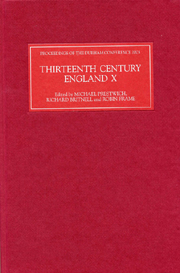Book contents
- Frontmatter
- Contents
- PREFACE
- ABBREVIATIONS
- The Meetings of Kings Henry III and Louis IX
- Counting the Cost: The Financial Implications of the Loss of Normandy
- Networks of Markets and Networks of Patronage in Thirteenth-Century England
- Three Alien Royal Stewards in Thirteenth-Century England: The Careers and Legacy of Mathias Bezill, Imbert Pugeys and Peter de Champvent
- The Eyre de terris datis, 1267–1272
- Joan, Wife of Llywelyn the Great
- Town and Crown: The Kings of England and their City of Dublin
- English Landholding in Ireland
- The Reception of the Matter of Britain in Thirteenth-Century England: A Study of Some Anglo-Norman Manuscripts of Wace's Roman de Brut
- Fearing God, Honouring the King: The Episcopate of Robert de Chaury, Bishop of Carlisle, 1258–1278
- Cloistered Women and Male Authority: Power and Authority in Yorkshire Nunneries in the Later Middle Ages
- Taxation and Settlement in Medieval Devon
- Clipstone Peel: Fortification and Politics from Bannockburn to the Treaty of Leake, 1314–1318
- Royal Patronage and Political Allegiance: The Household Knights of Edward II, 1314–1321
- ‘Edward II’ in Italy: English and Welsh Political Exiles and Fugitives in Continental Europe, 1322–1364
Town and Crown: The Kings of England and their City of Dublin
Published online by Cambridge University Press: 12 September 2012
- Frontmatter
- Contents
- PREFACE
- ABBREVIATIONS
- The Meetings of Kings Henry III and Louis IX
- Counting the Cost: The Financial Implications of the Loss of Normandy
- Networks of Markets and Networks of Patronage in Thirteenth-Century England
- Three Alien Royal Stewards in Thirteenth-Century England: The Careers and Legacy of Mathias Bezill, Imbert Pugeys and Peter de Champvent
- The Eyre de terris datis, 1267–1272
- Joan, Wife of Llywelyn the Great
- Town and Crown: The Kings of England and their City of Dublin
- English Landholding in Ireland
- The Reception of the Matter of Britain in Thirteenth-Century England: A Study of Some Anglo-Norman Manuscripts of Wace's Roman de Brut
- Fearing God, Honouring the King: The Episcopate of Robert de Chaury, Bishop of Carlisle, 1258–1278
- Cloistered Women and Male Authority: Power and Authority in Yorkshire Nunneries in the Later Middle Ages
- Taxation and Settlement in Medieval Devon
- Clipstone Peel: Fortification and Politics from Bannockburn to the Treaty of Leake, 1314–1318
- Royal Patronage and Political Allegiance: The Household Knights of Edward II, 1314–1321
- ‘Edward II’ in Italy: English and Welsh Political Exiles and Fugitives in Continental Europe, 1322–1364
Summary
The city of Dublin, having started life in the ninth century as a Viking encampment, had been in evolution for over 300 years by the time of its conquest by the English on 21 September 1170. For much of the tenth century its rulers also ruled the city of York, and it was minting its own coins, modelled on the Anglo-Saxon equivalent, by that century's end. In the early eleventh century there is some evidence of links with the Anglo-Danish empire, then a close if doomed partnership with the house of Wessex. The only visible effects of the coming of the Anglo-Norman and Angevin ages, until the late 1160s, were ecclesiastical ties, particularly with Canterbury, and an expansion in the market for Dublin's traders. The latter and their fellow citizens could in 1121 write collectively of themselves as omnes burgenses Dublinae civitatis. We know that they met regularly in an assembly, which was presumably not unlike the Folkmoot of London, and which the Dubliners called their Thingmoot (þingmót). Even if we had no documentary evidence for the Thingmoot, we should have to extrapolate its existence from the abundant surviving proof – archaeological, ecclesiastical, diplomatic, and so forth – of collective activity.
But in 1170 Dublin was conquered. A battle took place between its hereditary Hiberno-Norse ‘king’, Ascall Mac Turcaill, commanding a substantial military and naval force, and Richard de Clare (‘Strongbow’), sometime earl of Pembroke and Strigoil. The latter considered himself heir to the kingdom of Leinster because he had recently married the daughter of its king, Diarmait Mac Murchada, and, like most of his contemporaries, viewed Dublin as implicitly the province’s capital city.
- Type
- Chapter
- Information
- Thirteenth Century England XProceedings of the Durham Conference, 2003, pp. 95 - 118Publisher: Boydell & BrewerPrint publication year: 2005



